
Hertfordshire is a ceremonial county in the East of England and one of the home counties. It borders Bedfordshire to the north-west, Cambridgeshire to the north-east, Essex to the east, Greater London to the south, and Buckinghamshire to the west. The largest settlement is Watford, and the county town is Hertford.
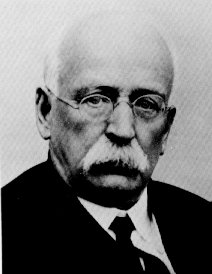
Sir Ebenezer Howard was an English urban planner and founder of the garden city movement, known for his publication To-Morrow: A Peaceful Path to Real Reform (1898), the description of a utopian city in which people live harmoniously together with nature. The publication resulted in the founding of the garden city movement, and the building of the first garden city, Letchworth Garden City, commenced in 1903.

Welwyn Hatfield is a local government district with borough status in the county of Hertfordshire, England. Its council is based in Welwyn Garden City. The borough borders Hertsmere, St Albans, North Hertfordshire, East Hertfordshire, Broxbourne, and the London Borough of Enfield.

Welwyn Garden City is a town in Hertfordshire, England, 20 miles (32 km) north of London. It was the second garden city in England and one of the first new towns. It is unique in being both a garden city and a new town and exemplifies the physical, social and cultural planning ideals of the periods in which it was built.
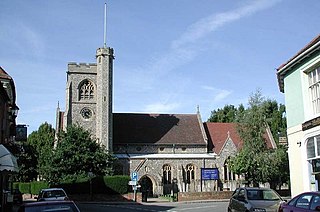
Welwyn is a village and civil parish in Hertfordshire, England. The parish also includes the villages of Digswell and Oaklands. It is sometimes referred to as Old Welwyn or Welwyn Village, to distinguish it from the much newer and larger settlement of Welwyn Garden City, about a mile to the south.
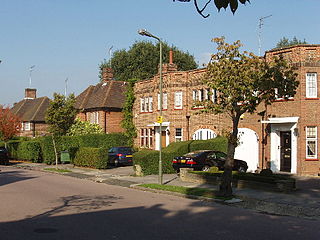
Hampstead Garden Suburb is an elevated suburb of London, north of Hampstead, west of Highgate and east of Golders Green. It is known for its intellectual, liberal, artistic, musical and literary associations. It is an example of early twentieth-century domestic architecture and town planning in the London Borough of Barnet, northwest London.
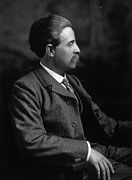
Sir Raymond Unwin was a prominent and influential English engineer, architect and town planner, with an emphasis on improvements in working class housing.

The garden city movement was a 20th century urban planning movement promoting satellite communities surrounding the central city and separated with greenbelts. These Garden Cities would contain proportionate areas of residences, industry, and agriculture. Ebenezer Howard first posited the idea in 1898 as a way to capture the primary benefits of the countryside and the city while avoiding the disadvantages presented by both. In the early 20th century, Letchworth, Brentham Garden Suburb, and Welwyn Garden City were built in or near London according to Howard's concept and many other garden cities inspired by his model have since been built all over the world.

Avenue House is a large Victorian mansion situated on East End Road in Finchley in the London Borough of Barnet.
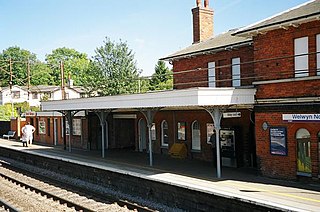
Welwyn North railway station serves the villages of Digswell and Welwyn in Hertfordshire, England. The station is located 22 miles (35 km) north of London King's Cross, on the East Coast Main Line. Train services are currently provided by Great Northern.

Letchworth Garden City station serves the town of Letchworth in Hertfordshire, England. The station is on the Cambridge Line 34 miles 50 chains (55.7 km) north of London King's Cross, and is a stop for services between King's Cross and Cambridge. Trains which serve the station are operated by Great Northern.
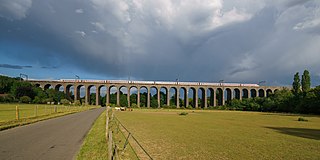
The Digswell Viaduct, also called Welwyn Viaduct, is a railway viaduct that carries the East Coast Main Line over the River Mimram in the county of Hertfordshire in England. A prominent local landmark, it is located between Welwyn Garden City and Digswell. It is just to the south of Welwyn North railway station.

Digswell is an ancient village and former parish in the English county of Hertfordshire which is recorded in the 1086 Domesday Book. The population of the urban area of Digswell in the 2011 Census was 1,632.

The Cloisters in Letchworth Garden City, Hertfordshire in the UK was built in 1905 as an open-air school dedicated to Psychology and where students were taught skills from the Arts and Crafts movement. After a period of neglect during World War II The Cloisters became the North Hertfordshire Masonic Centre in 1951.

William Harrison Cowlishaw (1869–1957) was a British architect of the European Arts and Crafts school and a follower of William Morris.

Letchworth Garden City, commonly known as Letchworth, is a town in the North Hertfordshire district of Hertfordshire, England. It is noted for being the first garden city. The population at the time of the 2021 census was 33,986.
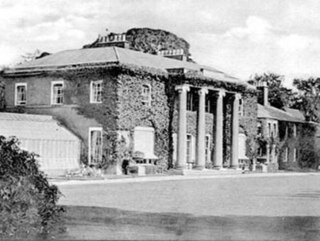
Digswell House is a Grade II listed Mansion in Hertfordshire, erected c. 1805–07 by Samuel Wyatt for the Honourable Edward Spencer Cowper, who lived there for some years. It was built in the parish of Digswell from which it takes its name, but was transferred to Welwyn Garden City in 1921. The house is now in the Knightsfield area of Welwyn Garden City. The current house was erected a little eastward of the site on which its predecessor had stood and was built as a commodious country gentleman's home, in an architectural style that can best be described as neoclassical. A portico, with four massive Ionic columns, on the south front is its most impressive external feature.

The Minories is a Grade II listed building and gardens situated at the east end of High Street in Colchester, Essex, England, near Hollytrees, Gate House and Colchester Castle. It currently houses The Minories Galleries which are no longer run by Colchester School of Art, part of Colchester Institute.
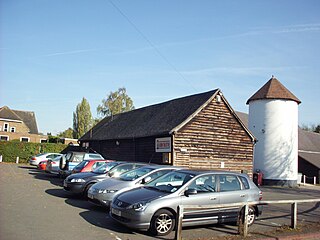
The Barn Theatre, located in Welwyn Garden City, England is a Grade II listed, 17th-century timber-framed barn converted to a community theatre in 1931.


















